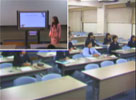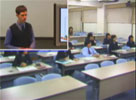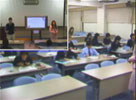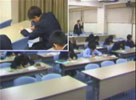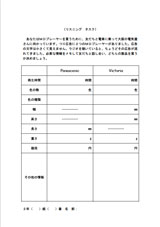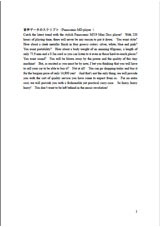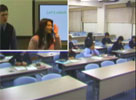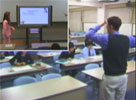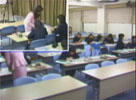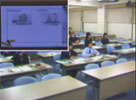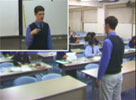
| Place |
 |
□Regular classroom □Computer room ■Special
classroom □Gymnasium
□Athletic Field □Outdoors □Others〔 〕 |
 |
 |
 |
| Type
of Lesson |
 |
■Class □Group □Pair/Individual □Follow-up □Others〔 〕 |
 |
 |
 |
| Phase |
 |
■Introduction ■Development ■Conclusion
■Others〔 individual study 〕 |
 |
 |
 |
| Main
user of IT |
 |
■Teacher ■Student □Others〔 〕 |
 |
 |
 |
| Objectives |
 |
■To introduce the topic □To motivate
students □As illustrative material used by the teacher □As illustrative
material used by the student ■To master through repetition ■To present
a model □To recollect past experiences ■To compare □To examine what
has been done/studied □To provide second-hand experience ■Others〔drills〕 |
 |
 |
 |
| Equipment |
 |
■Computer □Projector □Screen ■Electronic
Whiteboard □Visual Presenter □Digital Camera □Video Player □Internet □Digital
Contents □CD-ROM □Speakers ■Others〔 individula sound files 〕 |
|


| Providing learners with a dynamic explanation of grammar
and activities by presenting Web pages and authentic materials prepared
by native speakers. |


Comparatives
Contents: based on curriculum guidelines
Contents 1) Language activities
| A |
Listening |
|
(B) |
Listen to English being spoken or read
naturally and comprehend the details and/or important points. |
|
(C) |
Listen to questions and/or requests and
respond appropriately. |
| (2) |
Listen to questions and/or
requests and respond appropriately. |
| A |
Points to be considered through
the 3 junior high school years |
|
(B) |
In activities facilitating communication,
make sure that students are able to think of and use expressions appropriate
for each specific scene or situation, thereby broadening their language
abilities. |
| (3) |
Language materials |
| D |
Grammatical structure |
|
(E) |
Comparatives of adjectives and adverbs |
|


| (1) |
To enable students to compare comparatives and positives
of adjectives and be able to use them appropriately in context. |
| (2) |
To use IT materials effectively to encourage students
to actively communicate in English. |


| (1) |
Presentation of today’s objective.
|
|
[Abstract]
The entire lesson is conducted in English. |
|
| |
|
| (2) |
Explanation of grammar:
Role-playing by the teachers while presenting Web pages of commercial
products on an electronic information board.
|
|
[Abstract]
Practical materials prepared by native speakers are used. |
|
| |
|
| (3) |
Listening drills with individual
sound files (Listen to two different radio CMs for MD players, and decide
which one to buy.)
[Abstract]
Each student repeatedly plays sounds/sound files such as MP3 to compare
two products.
Worksheet(PDF file)
|
|
|
| (4) |
Confirmation of the information acquired
|
|
[Abstract]
Students grasp the grammatical structure of “comparatives” by presenting
product descriptions in English using it. |
|
|
| |
|
| (5) |
Explanation on how the presentation will be
evaluated |
|
| (6) |
Pair discussion and support by teachers |
|
| (7) |
Presentation using an electronic information
board and feedback |
|
| (8) |
Overall evaluation of today’s activities |
|


| (1) |
After this activity, the students are given
a speaking task using comparatives to recommend a product to the ALT,
which is regarded as the final goal activity of this lesson. |
| (2) |
Other activities, such as allowing students to choose
two products from websites for comparison, are also possible. |
| (3) |
The important key to a successful lesson when using IT
in class is to make sure that the purpose of using IT is fully understood
not only by the teachers but also by the students. |
| (4) |
The websites of various commercial products are full
of information such as pictures of the actual products and product specifications
(size, weight, etc.) that can be used in comparative expressions. Using
products (such as audio equipment, computer games, etc.) that are attractive
to students as teaching materials will not only enhance their interest
but will also create an activity using language in an actual situation
that will help students acquire and apply grammatical knowledge for actual
use. |

|

